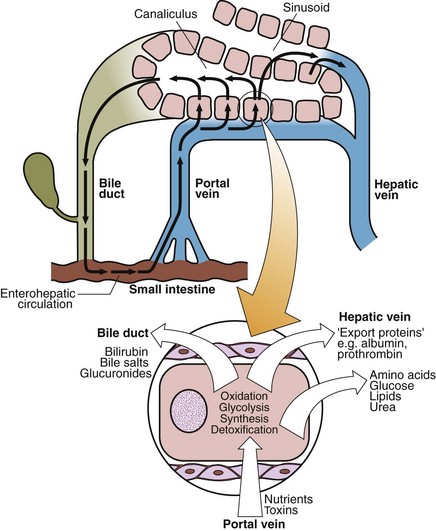28 The liver plays a major role in protein, carbohydrate and lipid homeostasis (Fig 28.1). The metabolic pathways of glycolysis, the Krebs cycle, amino acid synthesis and degradation, and the processes of oxidative phosphorylation are all carried out in the hepatocytes, which are well endowed with mitochondria. The liver contains an extensive reticuloendothelial system for the synthesis and breakdown of blood cells. Liver cells metabolize, detoxify and excrete both endogenous and exogenous compounds. Excretion of water-soluble end products from the metabolism of both nutrients and toxins, and of digestive aids such as bile acids, occurs into the biliary tree. Bilirubin is derived from haem, an iron-containing protoporphyrin mainly found in haemoglobin (Fig 28.2). An adult normally produces about 450 µmol of bilirubin daily. It is insoluble in water and is transported in plasma almost totally bound to albumin. It is taken up by liver cells and conjugated to form mono- and diglucuronides, which are much more soluble in water than unconjugated bilirubin. The conjugated bilirubin is excreted into the bile. Normal bile contains bilirubin monoglucuronide as 25% and the diglucuronide as 75% of the total, accompanied by traces of unconjugated bilirubin. The main functional constituents of the bile are the bile salts, which are involved in fat digestion and absorption from the small intestine. Serum bile acid concentrations are more sensitive indices of hepatic transport function than are total bilirubin measurements.
Liver function tests
Introduction
Liver function tests
Bilirubin
![]()
Stay updated, free articles. Join our Telegram channel

Full access? Get Clinical Tree


Liver function tests




